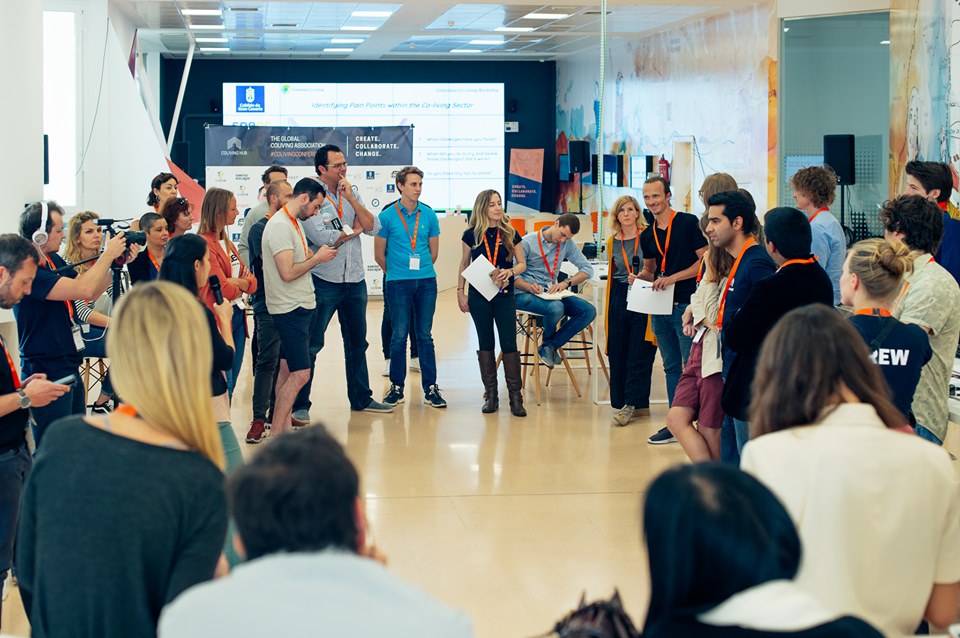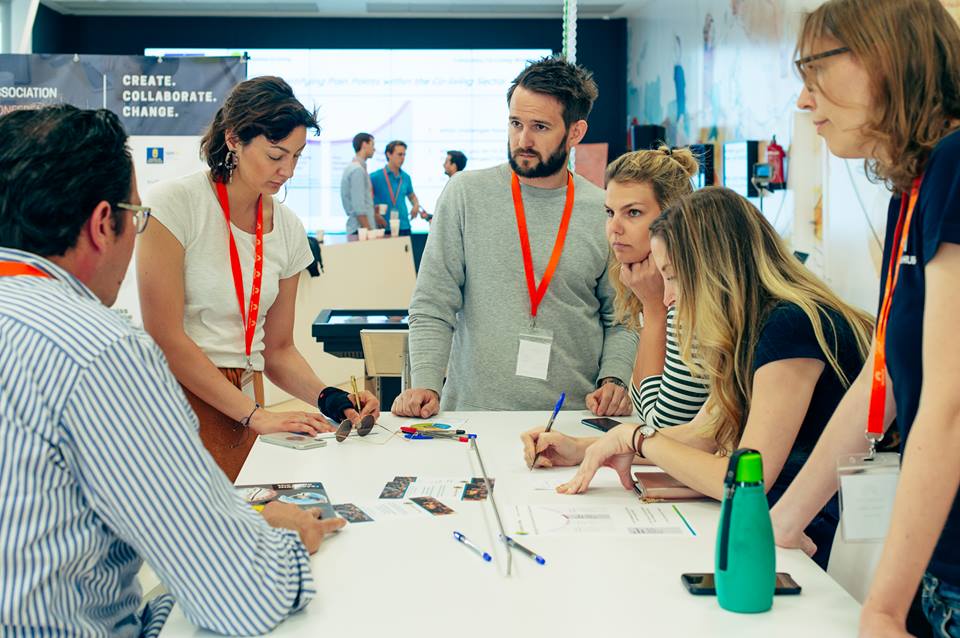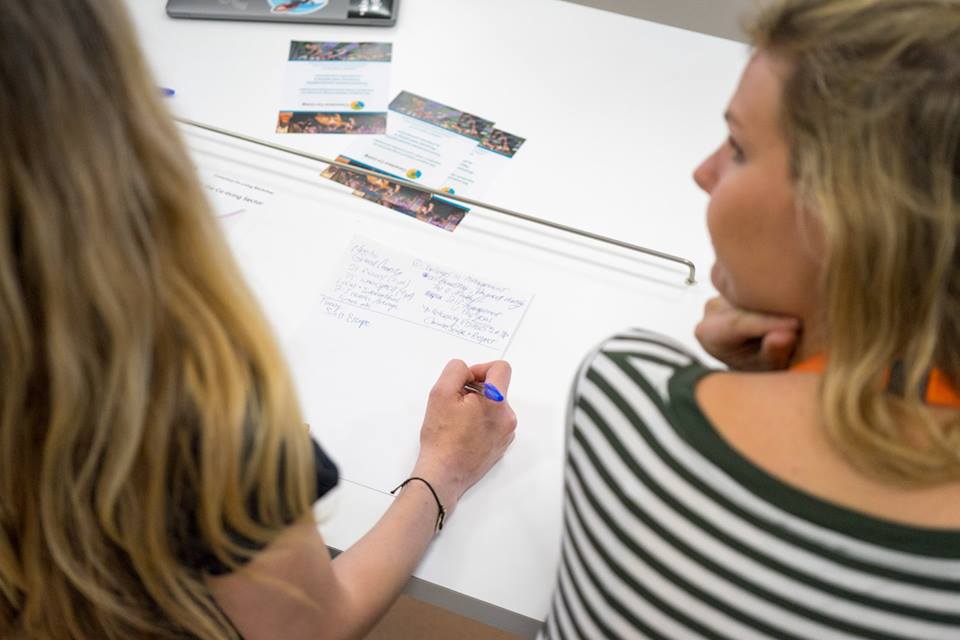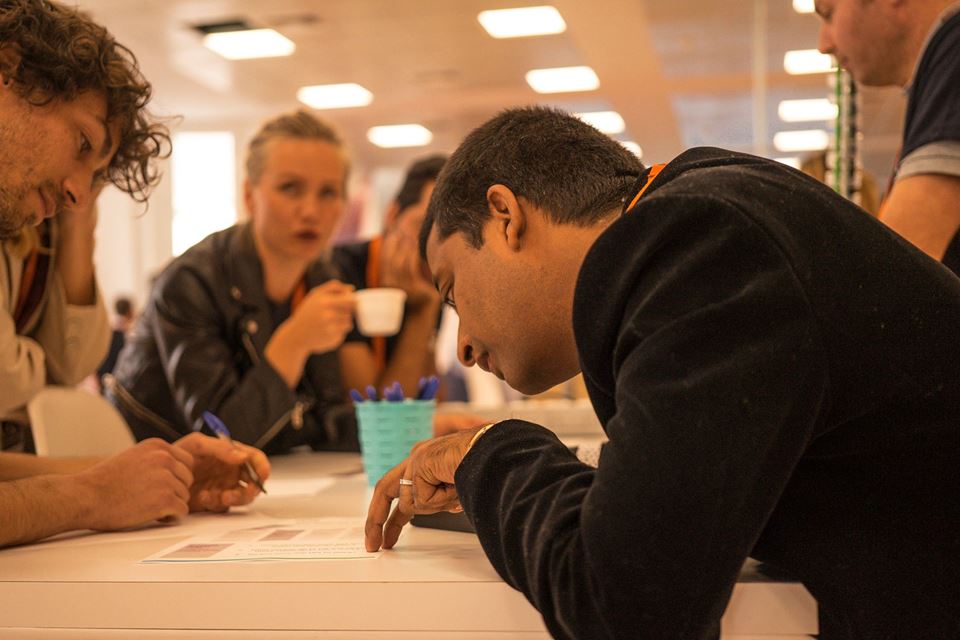The last weekend of April the Conscious Coliving team, coliving consultants, attended the Global Coliving Conference organised by Coliving Hub in Las Palmas, Gran Canaria. The weekend was full of inspiring talks and ideas for more sustainable and community oriented coliving initiatives.
We loved all the talks, but some that really resonate were from Smena Station around curation and onboarding through strong values, Seedspace about entrepreneur coliving hubs in emerging markets, Up(st)art about fostering creativity and art in their spaces and Anton Chernikov from Astir about placemaking and neighbourhood hubs.
There were loads of other inspiring talks and participants from around the world including Coconat, E-co, Outpost Club, Kndrd and more. We left inspired and reminded why we are doing what we do!
We also hosted a workshop during the conference that focused on The Four Pillars of Conscious Coliving. We asked participants to identify challenges and pain points they had experienced while operating a coliving space or trying to launch a space, especially in regards to our Four Pillars: Design of Physical Space, Wise Operations and Management, Sustainable Financial Model and Policy and Regulations.
We then asked participants to share any solutions they had come up with or ideas for getting around these obstacles. At the end the different groups shared their insights and we decided to record and share those insights here.
Below you will find a few main themes that came up during our workshop, especially in regards to our Four Pillars. At the end of this workshop summary you can also find the full transcription of our workshop, where you can do a deeper dive of the information shared during this workshop. We hope you find this valuable and let us know if you need any support in these Four Pillars for your coliving venture!

Credit: Coliving Hub
Design of Physical Space
Within our Manifesto and consulting offers, we recommend frameworks that allow for the physical environment that supports community, well-being, and environmental sustainability.
There are different standards and frameworks, such as WELL and BREEAM, that ensure developers design for social interaction, well-being and sustainability. We asked participants what were the challenges and key aspects for designing for coliving spaces specifically, and a few main themes came up:
The importance of human-centered and user-centric design – the need to figure out your audience’s needs and incorporate that into your design. We heard from participants working particularly in the more digital nomad/destinational kind of coliving sectors:
“…one of the first things to do is to ask your clientele what they need and what they expect from your space. So once you know your target, figure out how to reach your target and ask them – because we may have ideas on how to design the space and what to provide but they may not want it…So we were advised to think of the design of the place in terms of flexibility, we would need to accommodate tourists which may have different needs versus the needs of the long-term co-livers. So when we think of the design of the space we would have to think of both kinds of clientele.”
-Jaume Tomas
Another important learning that came up was to think about design hacks that respect cultural expectations. This came up with Smena Station, who operates in emerging markets. They said:
“We also got into some of the specifics of designing the space, so for example if it’s a shared room, you still have to provide enough storage space and it could be quite tricky in emerging markets like where we are when people don’t understand that we as Europeans have a lot of stuff. Lockers are also tricky, so on the one hand when our spaces are in emerging markets when want to have them because of safety first and convenience, but it also gives the feel that it’s not a safe space, it gives the sense that you cannot trust your co-livers.”
–Anastasia Klimova-Kuimov (Smena Station)
These cultural nuances are important to think about designing your coliving space, and architectural and cultural heritage is important to take into consideration and respect.
It was nice to hear from coliving operators around the world how they were dealing with designing coliving spaces, and nice to hear some operators talk about some concepts that we value at Conscious Coliving including buffer zones, modular and adaptable design and human-centered design.

Credit: Coliving Hub
Wise Operations and Management
The second Pillar that we discussed was Wise Operations and Management. We understand that this can be super tricky, and we encourage community facilitation practices and technology tools that allow for a community to be operated inclusively and efficiently. Some great learnings came out of this Pillar as well, including:
Facilitating self-managed communities – how brand loyalty and customer retention can create the containers for self management:
“…we learned that ideally having everything self managed is the pipe dream that we all have. We learned that the more returning visitors that come to our homes, the easier it’s self ran, because they already know what’s going on.”
–Christine McDannell (Kndrd)
Setting clear expectations and house rules – strong onboarding and curation with clear expectations will set the stage for smooth operations:
“And we talked about rules, and how it’s actually depending on how you define it, such as resident commitments or values versus using the word rules has actually helped because it reframes it in a positive way. We also talked about setting the intentions before moving in…Better to set the expectations up front.”
–Christine McDannell (Kndrd)
The challenge of scaling up operations -how can you keep true to your identity and values while scaling up business and opening new spaces:
“The major challenge that we had with the coliving spaces I’ve operated was how to scale up while keeping the same identity, and there were two main approaches and solutions to that. The first one is more of a top down approach where you give a certain structure…The second one would be more of a bottom up approach.”
–Gui Perdrix (Art of Coliving)
We very much believe and understand that without smooth operations and building maintenance, authentic community becomes a luxury. Basic needs must be met before humans can consider self actualisation. Through efficient and direct feedback loops coliving operators can iterate their offers in order to align with customer needs and wants. This article by Ollie’s Chris Bledsoe is an interesting take on Maslow’s Hierarchy Needs in a coliving context and ensuring smooth operations in order to achieve collective actualisation.

Credit: Coliving Hub
Sustainable Coliving Financial Model
The workshop conversation ended up around financial models and investments, also an area without any secret sauce, especially for coliving models that are still not widely understood by investors and planning authorities. We asked participants how they create coliving models that are financially sustainable and attractive for residents, operators, and investors. Some ideas included:
Hiring dedicated teams that are experienced in real estate investment – raising funds takes lots of time, so hiring investment teams can reduce wasting time and help get you in the door:
“Hire professionals. There are people that do this for a living… find them and they’ll do all that for you. They also are in the industry and have their own networks and can facilitate all that. It’s very difficult and it’s a full-time job: either you do it 100% yourself or you hire someone else that will and give them a cut.”
–Anton Chernikov (Astir)
Putting yourself in environments that are investor friendly – attending events where potential investors are meeting up:
“…there are a lot meet-ups that are investor related that you can go. Just go to meetup.com or Eventbrite and look up real estate investment meet-ups at local breweries that are usual an afterwork format. You can there and meet up with people that have funding. You can talk about your concept without even having a background in real estate and you can talk about what you want to do. So make sure you show up with some numbers: they’re going to ask you what returns you’re expecting and what kind of cash flow you have.”
–Lia Martinez (Geo Coliving)
Considering what kind of investments your business needs/wants – what kind of investors are you looking to partner with and for what?
“Some coliving companies use the real estate focused model but also most of the people here go for the traditional lease model, so they don’t want to own the place but they just want to be operators. So that is a challenge as well, and ask yourself how do you present yourself in front of an investor? If you have a really specific business model then you should base the search of your investors on the type of operations you want to implement.”
–Enzo Savelli (E-Co)
The consensus was that finding investments and raising funds is very time extensive and that if your founding teams dedicate their time on this then there may not enough time for operations. So finding consultants or hiring investment teams is a good way to ensure that the product is being developed while at the same time ensuring enough funds for the project.

Credit: Coliving Hub
Policy and Regulations
The final Pillar we discussed was Policy and Regulations. How do you position your coliving project so that you can obtain planning permissions and start developing your project? Some insights included:
Getting granular and understanding local context – get very specific with the needs and priorities of local authorities and political parties:
“It’s really going to be based on where you’re looking to start an operation and where you’re looking at working, you really have to get granular and understand where you’re trying to work. It’s also about asking questions: if you don’t know, reach out to people in the local government or in the local real estate crowd, and start asking questions about where the restrictions might lie and try to get help in that area.”
–Lia Martinez (Geo Coliving)
“So you have to understand where they’re coming from and you have to really work to their political motivations and also target boroughs that are going to be aligned with what you’re trying to do.”
–Anton Chernikov (Astir)
Taking out the term coliving from planning applications – to reduce time explaining the concept of coliving to planning authorities, be creative about how you frame your offer:
“Another suggestion from Anton is actually taking the word coliving out of the conversation because that can be a barrier. We get that question from a lot of people: ‘What is coliving’. And then you spend a majority of your talking time with that person just describing what it is in the first place. Whereas if you just reframe the conversation and talk about it in the light of coliving as a public service or within traditional framing.”
–Lia Martinez (Geo Coliving)
Once again, there is no silver bullet for obtaining planning permissions for your coliving space. Understanding and doing research on local regulations and political incentives can go a long way for where you position yourself and facilitating planning permissions. Framing your coliving project differently according to these political priorities (i.e. as affordable housing or sustainable solutions) can also make your offer more attractive to planning authorities and local councils.
This workshop was super insightful and we want to thank all the participants for their rich conversations and pertinent insights! We aim to host more of these workshops and gather more insights along the way, so stay tuned…

Credit: Coliving Hub
Event transcript
Design of Physical Space
Penny Clark (Facilitator): I hope everyone had some insightful conversations. So what came up for the group, what kind of challenges?
Jaume Tomas (future operator from Barcelona): Since we have to design a space, we were eager to get feedback and teachings from people more experienced than us, so they told us one of the first things to do is to ask your clientele what they need and what they expect from your space. So once you know your target, figure out how to reach your target and ask them – because we may have ideas on how to design the space and what to provide but they may not want it. Another thing is that because the space where we want to do the coliving space is very busy in the summer for 2 months of the year, July and August, we thought that because of the type of vibe we wanted to provide was not very aligned with the vibe during the summer, that we would stop the coliving during the summer and that we could reach out to more of the tourism clientele. So we were advised to think of the design of the place in terms of flexibility, we would need to accommodate tourists which may have different needs versus the needs of the long-term co-livers. So when we think of the design of the space we would have to think of both kinds of clientele.
Penny Clark (Facilitator): So yes that’s fantastic. Knowing your target market and knowing how they would like to use the space is so important when thinking about the design of your space.
Anastasia Klimova-Kuimov (Smena Station): We also got into some of the specifics of designing the space, so for example if it’s a shared room, you still have to provide enough storage space and it could be quite tricky in emerging markets like where we are when people don’t understand that we as Europeans have a lot of stuff. Also good to test buffer zones, to have between common zones and bedrooms: so a place where you can observe what is going on but also feel secure. Lockers are also tricky, so on the one hand when our spaces are in emerging markets when want to have them because of safety first and convenience, but it also gives the feel that it’s not a safe space, it gives the sense that you cannot trust your co-livers.
Penny Clark (Facilitator): It’s kind of a double edge sword there, when thinking about cultural expectations and practical hazards to take into consideration.
Wise Operations & Management
Penny Clark (Facilitator): So we have three more pillars to go. Who talked about Wise Operations and Management. What challenges have you encountered and what solutions have you come up with?
Christine McDannell (Kndrd): So there were a couple common themes, we learned that ideally having everything self managed is the pipe dream that we all have. We learned that the more returning visitors that come to our homes, the easier it’s self ran, because they already know what’s going on. Also another challenge was removing the owners and operators out of the operations, not being the ones to take out the trash or do any of the dishes. And we talked about rules, and how it’s actually depending on how you define it, such as resident commitments or values versus using the word rules has actually helped because it reframes it in a positive way. We also talked about setting the intentions before moving in. If your coupled with someone who is super clean but then someone moves in who is super messy, how do you handle those kinds of things? Better to set the expectations up front. Also incentivizing residents with drinks or pizza parties in order to keep clean environments.
Gui Perdrix (Art of Coliving): The major challenge that we had with the coliving spaces I’ve operated was how to scale up while keeping the same identity, and there were two main approaches and solutions to that. The first one is more of a top down approach where you give a certain structure such as Jeremiah’s example of ‘Accountability Groups’ and also incentivising people to go to those kinds of events that you want them to go to. So for example it could if certain people to go an event that they pay for and it gets withdrawn from their rent so this way you maintain a certain group identity. The second one would be more of a bottom up approach where you could apply some holocracy models as well as being very feedback driven both from residents and as well as from community managers. And if anyone is more interested in flat hierarchy organizations then check out the book called ‘Reinventing Organizations’ by Frederic Laloux.
Penny Clark (Facilitator): Great thank you Gui. So I can see in Wise Management and Operations there is that question about to what extent are residents your customers and to what extent are they are more citizens, and where to the top down rules meet the bottom up culture, and that’s just a fascinating question.
Sustainable Financial Models
Penny Clark (Facilitator): Moving on let’s talk about Sustainable Financial Models, Who was discussing this?
Enzo Savelli (E-Co): It was funny because I think that most of the people that were looking to raise funds were here at the table and they were all looking for advice that had previously raised funds and actually there was noone there for that. It was really interesting because we discussed about different topics like what the difference is between the financial model you build when you first start to run your business versus how it applies to the reality and what are the challenges and the strengths and weaknesses you want to preach to your investor, what kind of investor to approach. Do you partner up with real estate developers or do you go with traditional investors such and angel investors or VC’s? In terms of scaling approaches, we don’t have answers but we had different ideas. Something that came up from some guys who had been raising money for a couple of years was that for them raising money is really time consuming activity and that it seems they don’t have enough time to run their day to day operations and raise money and scale at the same time. Another really interesting point was that occupancy rates are really, really high and margins are really interesting compared to the traditional hospitality sector, as much as twice or three times higher than traditional models.
Penny Clark (Facilitator): So sounds like once you get running, you’re all good! Well you’re certainly in the right place with the right people to get some more insights about that.
Enzo Savelli (E-Co): If anyone has raised funds could they speak up please?
Penny Clark (Facilitator): Yes, please, does anyone have any tips to share about this?
Anton Chernikov (Astir): Hire professionals. There are people that do this for a living. Fundraising: they take a 6-10% cut … find them and they’ll do all that for you. They also in the industry and have their own networks and can facilitate all that. It’s very difficult and it’s a full-time job: either you do it 100% yourself or you hire someone else that will and give them a cut. But trying to do both is going to mean that both things are going to suffer.
Romulo Navarette (Seedspace): From our experience, if you don’t have enough credibility investors will ask too many questions and it is really is a full-time job to know how to answer those questions. Normally the Founder or the CEO should be the one doing the fundraising. You really have to dedicate time for this.
Matt Lesniak (Conscious Coliving): Just as another example, The Collective have quite a large team, over 100 people in the team some of them are more Product oriented such as design, construction, development and all that, some of them are more Ops, some of them are more Community but they do have one full department just for their investments and as Anton was saying they do hire professionals that have real estate investment backgrounds and they have different investment teams in each of the cities they are so they have local knowledge, local connections and local expertise.
Enzo Savelli (E-Co): Just to wrap up, I want to talk about how to raise money and what for exactly. Some coliving companies use the real estate focused model but also most of the people here go for the traditional lease model, so they don’t want to own the place but they just want to be operators. So that is a challenge as well, and ask yourself how do you present yourself in front of an investor? If you have a really specific business model then you should base the search of your investors on the type of operations you want to implement.
Penny Clark (Facilitator): Last comment on this please.
Lia Martinez (Geo Coliving): I just wanted to comment on this from a smaller scale perspective, because I know we’re hearing from people working in the 300+ unit range. So on a smaller scale, I know in the US it exists and I’m sure in Europe it does as well, there are a lot meet-ups that are investor related that you can go. Just go to meetup.com or Eventbrite and look up real estate investment meet-ups at local breweries that are usual an afterwork format. You can there and meet up with people that have funding. You can talk about your concept without even having a background in real estate and you can talk about what you want to do. So make sure you show up with some numbers: they’re going to ask you what returns you’re expecting and what kind of cash flow you have. You could do that on single family residential properties or even multi-family unit properties and you can get someone to go there with you. You might meet someone at one of these meet-ups that might have half a million dollars in their back pocket and it’s a way you can partner with other people or get them to invest in one of your properties.
Policy & Regulations
Penny Clark (Facilitator): Thank you that’s a really great tip. So finally we’re going to talk about Planning Policy & Regulations. So which groups want to talk about this?
Lia Martinez (Geo Coliving): We started off by talking about how different laws and regulations change according to the location where you’re living. What happens in Europe might be based more on a licensing issue that we run into; I know we were talking about licensing in Spain and how it might be difficult to run a coliving operation, it might be a multiyear long process. Whereas in the U.S. it might be a zoning barrier or group housing laws being a barrier with certain amounts of unrelated persons allowed to live in one house at one time. It’s really going to be based on where you’re looking to start an operation and where you’re looking at working, you really have to get granular and understand where you’re trying to work. It’s also about asking questions: if you don’t know, reach out to people in the local government or in the local real estate crowd, and start asking questions about where the restrictions might lie and try to get help in that area. We also talked about framing the conversation with government officials. If you’re trying to get something done, or if you’re trying to get funding or get zoning changed, try to frame that conversation with your government officials or government administrators based upon the desires of that government. So in Europe we talked about how there is a big push towards sustainability, towards being green and environmentally friendly, and as that gets bigger and bigger and becomes more of a focus, when you talk about coliving, make sure that those things become a focus on how you’re framing your conversation. And in the U.S., we’re more interested in affordable housing, so framing it in a conversation of bringing in affordable housing into that sphere, really trying to make it a win-win for all sides. We talked about how coliving is not classified, so it’s important to try and work within the current laws and convincing politicians and decision making power that coliving is a public service. Another suggestion from Anton is actually taking the word coliving out of the conversation because that can be a barrier. We get that question from a lot of people: ‘What is coliving’. And then you spend a majority of your talking time with that person just describing what it is in the first place. Whereas if you just reframe the conversation and talk about it in the light of coliving as a public service or within traditional framing. Anton do you want to talk more about that?
Anton Chernikov (Astir): There are certain councils that actually resists the kind of more citywide policy because they don’t want to have conservatives in Labour area or Labour voters in a conservative part of the city. So they will specifically stop developments and housing typologies that will create problems for them in the next election. So you have to understand where they’re coming from and you have to really work to their political motivations and also target boroughs that are going to be aligned with what you’re trying to do. That is really important to study and to try and understand if you want to pass go. It’s just the way it is.
Penny Clark (Facilitator): So thank you very much to both of you that was very interesting and no doubt really useful to everyone here. So I hope you found this workshop useful and you were able to talk to people you weren’t able to talk to before and hopefully shared some challenges and shared some insights.
This article has been coauthored for you by:
Penny is Director of Research & Sustainability at Conscious Coliving. She has an MSc in Social Research Methods, and her PhD explores how shared living may enable lowered environmental impacts. She has consulted on numerous shared living projects, specialising in impact strategy, concept, and community. Penny has presented at conferences including the Co-Liv Summit, the Urban Living Festival, BTR360 and more. She has also authored publications in The Developer, Coliving Insights Magazine, the book Urban Communal Living in Britain, as well as being interviewed by the BBC and the Guardian about shared living.
Matt is responsible for designing community experience and impact strategies and measuring the social value of coliving communities. Matt is also a founding member and current Head of Community of Co-Liv and has worked for The Collective on their Impact Team.
Tom Manwell is a fully qualified U.K. architect. Before founding his two current companies, Tom gained experience with a range of award winning practices working on small, medium and large scale residential schemes in London, the U.K. and Europe.